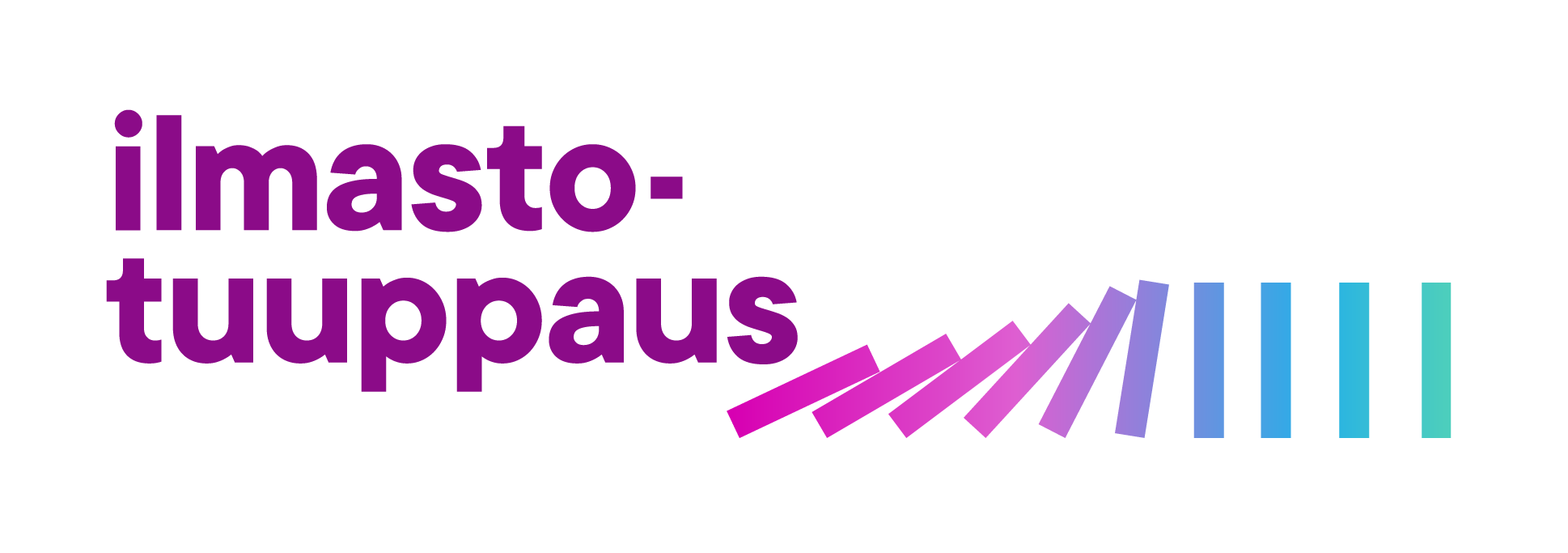
Jump to contents of this page:
What is design
The purpose of this Design your own nudges chapter is to inspire the use of design thinking and tools in the planning of nudges and to encourage experimenting with new co-creation methods. This guide is not exhaustive, and you are welcome to search additional information and inspiration from various sources. The handbook is intended for everyone, so here is a small glossary to help you along the way:
- Design: Design is the process of creating solutions that are functional and appealing for the users. It involves planning, problem-solving, and creativity to make things work better.
- Design thinking: Design thinking is a problem-solving approach that focuses on understanding people’s needs, brainstorming ideas, and testing solutions to improve products, services, or experiences. It is a mindset that emphasizes empathy, collaboration, embracing ambiguity, curiosity, and taking action.
- Iterative: In design thinking, the nudging team may jump from one phase to another, and the phases don’t necessarily follow each other chronologically. For example, on testing a prototype or a pilot, teams may find something new about their target group and understand that they must redefine the problem.
In this playbook, we offer you knowledge and experience of nudges organized to enhance more sustainable public transportation. As we know, the context and goal of nudges can vary a lot, so it is necessary to use imagination and creativity in choosing and using tools. The purpose of these tools is not to provide a rigid procedure for implementing nudges, but rather flexible templates that should be applied creatively and experimentally. You can modify the tools to serve the purpose that is best for your case.
How to utilize design thinking for nudging?
Design thinking provides methods for guiding behaviour through nudges that can promote better decisions, for example, for the environment and health. The challenge, however, lies in designing nudges for target groups that feel genuinely helpful and natural. Planning a nudging intervention can be approached similarly to designing any other service. Various service design methods based on customer-centric thinking can assist in this process. Many nudges are linked to existing services, such as public transportation, forest services, or dining in restaurants. When integrating an intervention into a service, it’s essential to consider its impact on the overall customer experience. We suggest enriching nudge design by utilising design thinking and available design tools that aid the nudging team in project management, understanding the target audience, and documenting the process.
A key element of design thinking is empathy. Empathy means understanding other people’s perspective and daily life: the environment in which decisions are made, what brings joy or frustration, and what needs the customer has in different situations.
This perspective is particularly valuable when designing nudges as part of broader services, such as public transportation, where the needs and experiences of service users directly impact the effectiveness of the nudges.
This perspective is especially useful when designing nudges as part of broader services, like public transportation, where the customer’s needs and experience directly influence the success of the nudges.
Design thinking helps to get an understanding of the constraints and advantages that can have remarkable impact on the success of the interventions. The main advantage of design tools is that they enable nudges to be planned so that the micro-levels of the experience are documented and analyzed. They help to capture the details of everyday situations and to create nudges that are more relevant and meaningful. Additionally, these tools can be applied to both physical and digital service environments, expanding their usability across various nudging projects. Design methods can be used as a management approach in creating new ideas but also improving the existing services.
Design thinking methods and tools
Next, we will go through the basics of design thinking and some design tools that you can use to enrich your co-creation practices and document and visualize the results of your work. The design process consists of understanding and defining the problem, but also designing and testing the solution:
Double diamond is a common and widely used way to understand the process of planning (British Design Council). It represents the way the problems and solutions are placed in the design process, and it can be applied to the intervention planning in third sector, public organisations and companies. The double diamond visualizes that teh design process needs divergent and convergent thinking.
In the first diamond, the problem diamond, the information is gathered and the problem is defined. In the second diamond, the solution diamond, the possible ideas are developed and delivered. Divergent thinking in the first part of the diamond helps to explore and broaden the perspectives as you search for information on the phenomena, previous nudges and the people you are targeting the intervention. Convergent thinking helps to deepen the understanding of the target people and to define the problem. In the second diamond divergent thinking helps to ideate the solutions to the defined problem and convergent thinking is narrowing the scope and aiming to find the right approach and intervention methods.
Research – discover and emphatize
Since nudging has been an increasingly common approach in public policy and societal design ever since the publication of Thaler and Sunstein’s book ”Nudge”, there are likely already numerous nudging experiments from which you can draw ideas and insights.
Examine why the intervention was implemented, what it aimed to achieve, and what methods were used. Consider whose behavior was targeted for change and in what context. Analyze the outcomes the nudging intervention has produced. What can you learn from these interventions?
Once you have gathered data during the discover phase, start visualizing the information for example into potential personas and customer journeys as soon as possible. At this stage, you can already begin sketching possibilities for a nudge prototype. It is important to note that the double diamond is not a linear process but an iterative approach to design thinking.
In the first phase of design thinking, you work to understand people you are planning to nudge. Identify key behaviors and decision-making processes relevant to the nudge you wish to design. This involves understanding what drives people’s actions and what barriers they face. For example, if you’re looking at the use of public transport, observe how people make decisions about their travel choices, what information they rely on, and what factors influence their choices. Also, focus on the bias that might affect their decisions.
Some possible methods are:
- Interviews
- Focus group
- Survey
Define – what is the problem we are solving?
The Define phase clarifies the problem you’re tackling, focusing on diagnosing the underlying reasons for the behavioral issues and how they relate to biases.
Dive into social and cognitive factors driving the behaviors identified during the empathize phase. Analyze the existing data to identify the most influential biases. For the case of public transport, people might want to use the car they own instead to take the train (the sunk cost fallacy), or they are overwhelmed by complex choices (choice overload). This analysis helps you frame the problem accurately by understanding not just what the behavior is, but why it happens.
During the definition phase, test the idea with the target group and stakeholders in workshops. Aim to understand the level of acceptance the planned intervention has among them. Seek to identify potential barriers, attitudes, practical challenges, values, interests, and opportunities related to the intervention.
Some possible methods are:
- Persona
- Journey map
- Survey
- Interview
- Stakeholder map
- Workshop
Develop – find your strategy
The Develop phase involves generating creative solutions for the intervention options. You determine what type of nudges or interventions could influence the target behavior in the desired way. During ideation, the nudging team can be brainstormed to get a plethora of ideas before choosing the suitable approach. To encourage people to use public transport, some strategies might be simplifying choices.
Leverage the multidisciplinary expertise of your team as well as the knowledge and ideas of stakeholders. Aim to gather multiple ideas during an ideation workshop, from which one promising idea can be further developed. Encourage participants to think outside the box while maintaining an empathetic understanding of the target group’s life and context.
- Journey Map
- Concept
- Brainstorm
- Service Blueprint
- Stakeholder map
- Workshop
Test – iterate and deliver
In the Test phase the nudging team starts to build and test the ideas. Prototyping means creating a trial version of a service or a product and testing the nudge in real-world settings. If you are designing a nudge to increase using the public transportation, you might need to work with the city planning in improving the bus routes, ticket systems and inform people about the best routes.
Consider the context of the event: what happens before participating in the intervention, during it, and after it. Nudging can be viewed as a customer journey, where the individual interacts with the service at various touchpoints, receives information, and makes decisions. The design of the nudge can be compared to customer experience design, where the focus is on the multi-channel nature of the experience and the user’s perspective throughout the process.
It is possible to create prototypes by using different methods. The idea of prototype is that creating it is cost efficient and modifying and editing it is easy. For example, with LEGO Serious play method it is possible to model the urban environment for ideating more sustainable transportation solutions. Paper prototypes are suitable to simulate e.g. information nudges and to gather feedback from potential users.
Different kinds of digital platforms like Miro, Mural and FigJam help to create clickable prototypes and to test how digitalized or gamified nudging ideas work. The developed idea is tested with users and modified based on the feedback received. If it becomes evident that the chosen approach is not working, the nudge can be iteratively refined along the way. It does not make sense to continue with inadequate practices and approaches, if it is possible to see that they do not lead to indented consequences.
Some possible methods are:
- Prototyping
- Service Blueprint
- Interview
- Survey
Tools for designing nudges
Next, we will introduce an idea of workshops, and a few commonly used design tools that you can apply in the practical planning of nudges. On the following pages, each tool is presented along with a speech bubble highlighting the benefits of using it.
You will also see whether the tool is typically used in the research, define, develop, or test phase, or whether it is suitable for multiple stages of the design process. In addition, you’ll find practical tips for using each tool effectively.
After the tool pages, you’ll see a sample canvas we’ve filled out based on the pilot nudges presented in the chapter Nudge co-creation examples. Finally, you’ll receive a blank version of the canvas that you can use for your own purposes.
Workshops
Phases: Research/Define/Develop/Test
Workshops are designed for collaboration, brainstorming, or problem-solving. They have a structured agenda with activities and exercises. Workshops require active participation from attendees, and it is led by facilitator who guides discussions, ensures inclusion and keeps activities on track.
- Workshops produce tangible results such as plans, frameworks, ideas or prototypes. Workshops encourage creative thinking and innovation in a safe and open environment for dialogue. Workshop can take place in any phase depending on the goal and purpose of the workshop.
- Organize workshops to develop ideas and solutions.
- Use methods like brainstorming or empathy mapping to align stakeholders on shared goals.
- Involve stakeholders into the design process through activities like prototyping and user journey mapping.
- Let stakeholders to test and comment the prototype of nudging to ensure solution is relevant to the target group.
Facilitating workshops
Preparation is important in facilitating successful workshops. First, invite the right people for the purpose of the workshops. Define purpose and set a clear goal. Despite thorough preparation, surprises can still occur during a workshop. Something might take much more time than anticipated, or other unforeseen issues may arise. Therefore, it’s good to maintain a flexible mindset, allow some breathing room in the workshop, and review the next steps together, discussing how to proceed moving forward. Building trust among participants is important, especially when they are unfamiliar with each other.
Through facilitation, collaborative work can be made easier, and group processes can be guided effectively. The facilitator acts as a guide, supporting and engaging participants in working towards a common goal. Facilitation helps promote equal participation, interactive communication, adherence to schedules, and achieving productive results.
- The facilitator listens to the group and creates conditions for equal and open dialogue. The facilitator remains neutral, steering the discussion without expressing personal opinions. Advancing their own agenda is not part of the facilitator’s role; instead, they approach all participants with an open mind.
- Set a clear goal for the workshop. If the goal is broad, divide the work into distinct phases, possibly across different days.
- Create a plan according to the goals of the workshop. Consider the rules for the discussion and exercises and make sure that every participant is heard, and their participation is meaningful. Let participants think about the topics first by themselves and let them express their opinions democratically. Good facilitation ensures that the loudest voices don’t lead the situation.
- Allow enough time for decision making and creating synthesis of the handled topics. Also, it is good practice to discuss the next steps and the practical applications of the results of the workshop.
- Use digital collaboration (e.g. Miro, FigJam) for brainstorming and sharing ideas remotely.
Persona
Phases: Define
Personas are example cases of a target group of people with shared interests, common behavior patterns and other similarities. The information is based on previous research and other data available. The idea of personas is to keep the nudging team empathizing towards who you design for and get inspired by their life and challenges.
Creating 2-4 core personas representing the main personas is usually enough. Define personas based on the gathered data and complement them with creativity. It is a good idea to occasionally take a moment to evaluate your personas, and think are they realistic enough. Do not rely too much on demographics, like age or gender, as they do not give so much information on a person’s values, needs or challenges. You can utilize the Empathy map in creating the personas or make an extinction to it by adding goals, needs, frustrations, fears or other factors to it. It is also a good idea to create some “edge personas”, for example people that are not the most obvious persons to ignore the nudges you are planning.
This persona canvas illustrates a person’s habits, gains and pains to get engaged and reasons to use the service the nudging is embedded in. This persona card is based on workshops conducted with elderly individuals and a persona representing a 77-year-old woman named Leena. Click the image to view it in a larger size.
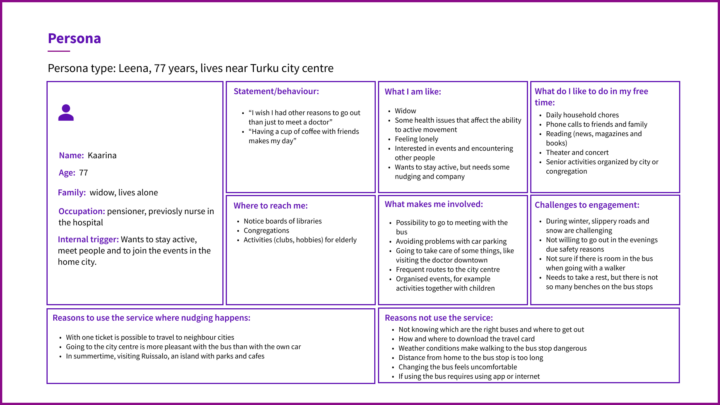
Download the Persona file file in PDF format:
Empathy map
Phases: Define
An empathy map is a design tool that provides a deeper understanding of a customer’s needs, emotions, motivations, and challenges. With the map, a nudging team can identify factors that influence the target audience’s behavior.
The empathy map is divided into four sections: what the person sees, hears, thinks, and feels. This tool can be used, for example, to explore which aspects of everyday life support or hinder the target group in making environmentally friendly choices.
- Think and feel: What is the most important to them? What are they dreaming about? What are they worried about and what makes them happy?
- What they hear: describe who influences their opinions. Which media do they follow, whose advice they appreciate?
- What do they see: What do their environment and context look like? Who are their peer groups? What kind of services are they using?
- Says and does: What is their attitude? Is their speech and actions aligned or contractionary?
- Pain: What makes them frustrated? What kind of barriers do they have? What kind of risks do they tend to avoid?
- Gain: What do they want to achieve? By which means?
This empathy map illustrates a person’s motivations, barriers, incentives, and social environment. The empathy map is based on workshops conducted with elderly individuals and a persona representing a 77-year-old woman named Leena. Click the image to view it in a larger size.
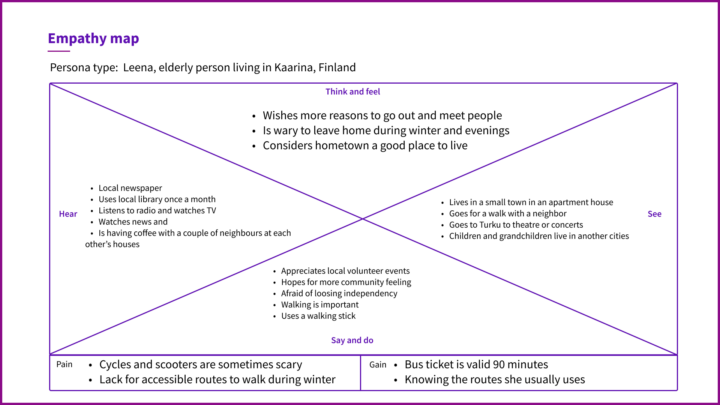
Download the Empathy map file in PDF format:
Concept
Phases: Develop
Creating a concept helps to build common understanding and strategy of the idea of intervention. A common concept helps break down silos and improve collaboration.
- Work together with your team to find answers to these questions. What is the behaviour you aim to influence? What are the means and goals of the intervention?
- Who are participants and stakeholders and what are their pain points, problems, understanding of the situation and field, what is important for them, how are their capacities and ideas. Who are the stakeholders and what is their role (stakeholder map).
This canvas shows an example of a concept canvas that presents an example of a gamified lesson plan. The purpose of the gamified lesson is to teach schoolchildren about the benefits of public transportation and the practicalities of traveling by bus in a fun and engaging way. This concept is based on team work to design a gamified lesson. Click the image to view it in a larger size.
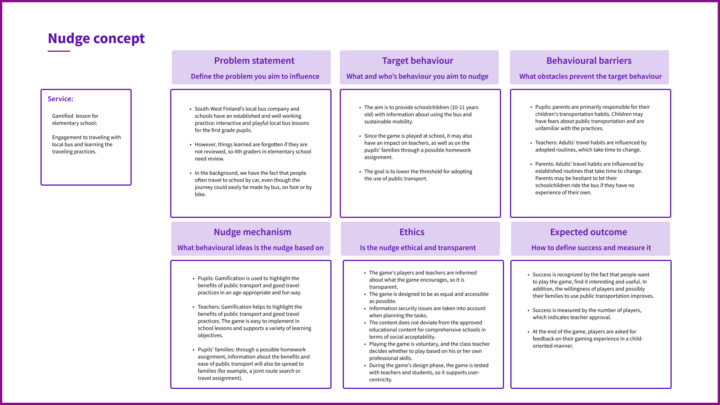
Download the Nudge concept file in PDF format:
Journey Map
Phases: Research/Define/Develop
A Journey Map illustrates the person’s entire experience throughout a service, detailing the various stages and touchpoints. It can be used to document the current customer journey in a service or to develop a new type of service.
This tool helps the nudging team follow the customer from the start of the service to its conclusion, allowing them to examine where nudges have the most impact. For instance, if the goal is to encourage more sustainable travel behavior, the journey map helps identify at which points the traveler encounters opportunities to choose a more environmentally friendly option and what influences or hinders that choice. Journey maps are a way to visualize experiences.
Select the persona whose journey you will design. Decide if you are using the map for collecting information about existing customer journeyswithin a certain service or are you designing the whole new service.
Determine the scope and level of detail for the journey steps. Are you mapping a journey that spans an hour, a day, a week? Define the key stages of the journey, such as “before purchasing tram ticket” “during purchasing a tram ticket,” and “during a tram ride.” Identify the touchpoints where the person interacts with the service and outline the steps they take at each stage.
Consider how choice architecture can be integrated into these steps and interactions to guide behavior. Use a customer journey template to document the process. Along the design process, continuously refine the journey plan based on feedback and observations.
Below is an example of a journey map illustrating a person’s experience with public transportation. The journey map is based on a persona representing an 81-year-old man named Matti. It outlines his activities, touchpoints, needs, and opportunities for nudging him towards increased use of the local bus service. Click the image to view it in a larger size.
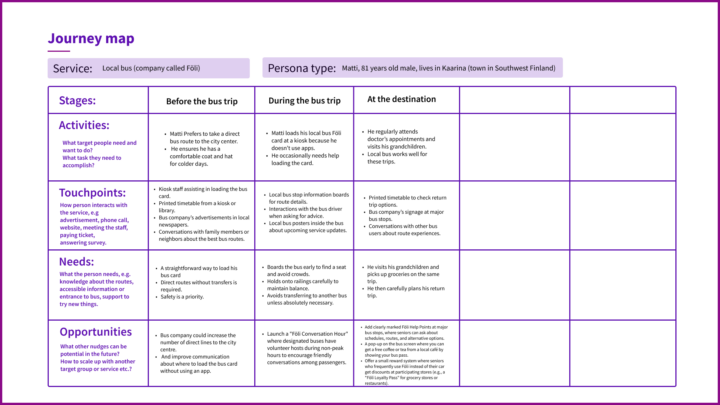
Download the Journey map file in PDF format:
Service Blueprint
Phases: Develop
A Service Blueprint is a comprehensive mapping tool that complements the Customer Journey Map by including the service’s background processes, such as the roles and responsibilities of stakeholders and the service provider organization.
Nudges occur within networks of stakeholders, and a service blueprint helps examine and document the needs of various stakeholders and the related touchpoints. The service experience can be compared to a theater performance, where the ”frontstage” represents the customer-facing part of the service, and the ”backstage” represents the organization’s internal operations. This breakdown is particularly useful for designing nudges, as successful nudging often requires collaboration among different stakeholders. For instance, a nudge aimed at promoting more sustainable travel behavior requires cooperation with hotels and other services. The service blueprint clarifies these roles and ensures that all necessary background processes support the desired outcome.
Service Blueprints are extensions of journey maps. The idea of Service Blueprint is to connect people’s experiences with the frontstage and backstage processes. Service Blueprints adds layers of depth to show relationships of front- and backstage processes. It shows the “line of visibility” which marks the line of what a person sees and experiences and what needs to happen to be able to organise certain experiences and choice architecture.
For example, if you are designing a service that combines public transport and car parking, think about what has to happen to make the service possible in the physical world, what kinds of actions need to be designed between devices and software, and how services users perceive these interactions.
Below you can see an example of a gamified elementary school lesson that teaches how to use buses and inspires sustainable mobility. This Service Blueprint specifically takes into account the teacher’s experience, as they are key in using the game. Click the image to view it in a larger size.
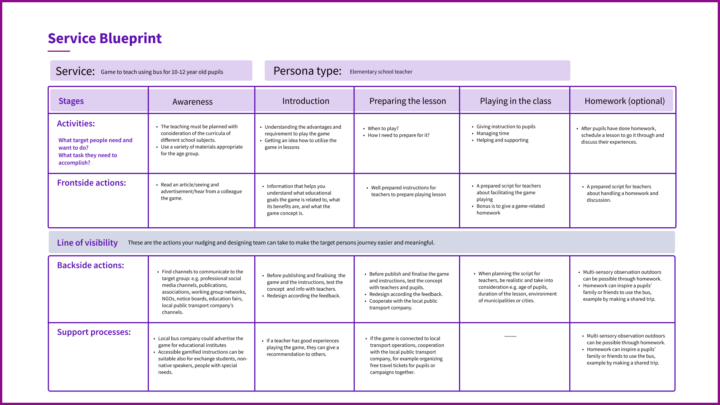
Download the Service Blueprint file in PDF format:
Service Safari
Phases: Research/Define/Develop
A service safari is a hands-on tool where designers experience the service from the customer’s perspective. Service safari can help to explore the optimal nudges and improves empathy as it helps to think about the journey from the perspective and the context of the customers.
For example, if the goal is to encourage hotel guests to make environmentally friendly choices, the nudging team can go through the service as a hotel guest, observing where the guest makes choices, such as selecting vegetarian meals, finding information about bike storage, or learning about the hotel’s environmental strategy. This approach helps identify effective opportunities for nudges. Service safari can be conducted in physical or digital services. It could be a good learning opportunity to go through other services by using service safaris methods.
Nudging team can be the researchers of the safari by themselves. Set the goal the target group might have, for example “hire a bike and drive from city center to the tennis court”. How to find out who offers rentable bikes? How to reserve a bike? How is the purchasing? What happened during the cycling? Evaluate the tasks the person needs to take and observe what they experience. Are there situations where nudging could help people to make choices towards active cycling? For example, use the journey map template to visualize your insights and experiences during the service safari.
Stakeholder map
Phases: Research/Define/Develop
Typically, nudges are designed to happen in a certain situation that is not happening in a vacuum. Stakeholders are people, organizations and companies connected to the intervention. Thus, co-creation with stakeholders is a vital part of planning an intervention.
Stakeholder is anyone with an interest in your intervention project. For example, officials, decision-makers, citizens, NGO’s and companies are stakeholders. Stakeholder maps help to identify and illustrate the people and organizations involved and connected to the intervention.
Which stakeholders are the most important? Who are the key stakeholders – they have the most influence over the intervention. Primary stakeholders are the people who will be impacted directly by the intervention.Secondary stakeholders are indirectly impacted by the intervention. Think about the following questions: What are the expectations of the stakeholders? What do they expect to happen as a result of the intervention? Are there competing agendas?
Below you can see an example of a stakeholder map we used to design a gamified elementary school lesson that teaches how to use buses and inspires sustainable mobility. Click the image to view it in a larger size.

Download the Stakeholder map file in PDF format:
Nudge retro
Phases: After test
The nudge retrospective dedicates time to reviewing a completed intervention and learning from both the successes and the failures. The purpose of the retrospective is leveraging the teams and organizations learning and improving their ways of working together.
Organize a retro session with the nudging team. Observe the intervention afterwards. How did we succeed? What could we have done better? Why? What have you learned? Let everyone write their thoughts first alone and then discuss them together.
It is highly possible that during the nudging process, you will discover aspects that did not work as expected. These might be related to the chosen target group, the specific temporal and local context, or the experiment conducted within the framework of a particular service. It is also possible that you came up with new valuable ideas and connected with stakeholders who could become fruitful partners in designing future interventions. Be sure to document all insights and lessons learned about stakeholder collaboration, documentation, and improving cooperation. Since designing nudges requires teamwork, don’t forget to express your gratitude to your team and partners!
Below you can see a retro canvas about a sub-project of planning a workshop for seniors where we tested public transport route search service and discussed upcoming transport changes. Click the image to view it in a larger size.
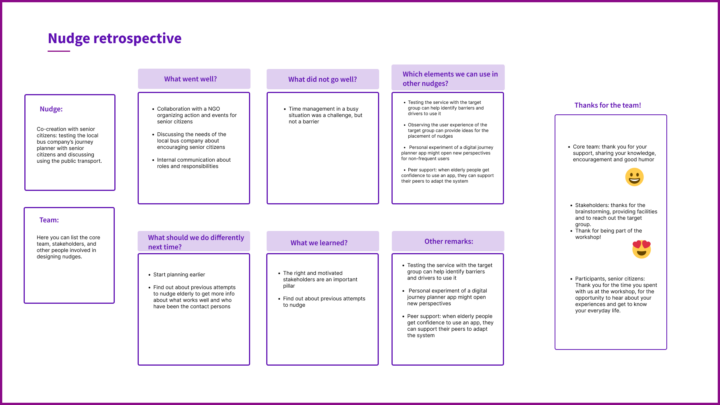
Download the Nudge retro file in PDF format:
Looking for more design inspiration? Many service design resources are available online or in the library, for example:
Marc Stickdorn, Markus Hormess, Adam Lawrence, Jacob Schneider (2018): This is Service Design Doing. O’Reilly Media Inc.
Marc Stickdorn, Marc & Jacob Schneider (2021): This is Service Design Thinking. 9th edition. BIS Publishers.
Service Design Network: https://www.service-design-network.org/
Service Design Tools: https://servicedesigntools.org/
The Fountain Institute: https://www.thefountaininstitute.com/blog/free-design-toolkits
Design council: https://www.designcouncil.org.uk/our-resources/the-double-diamond/
